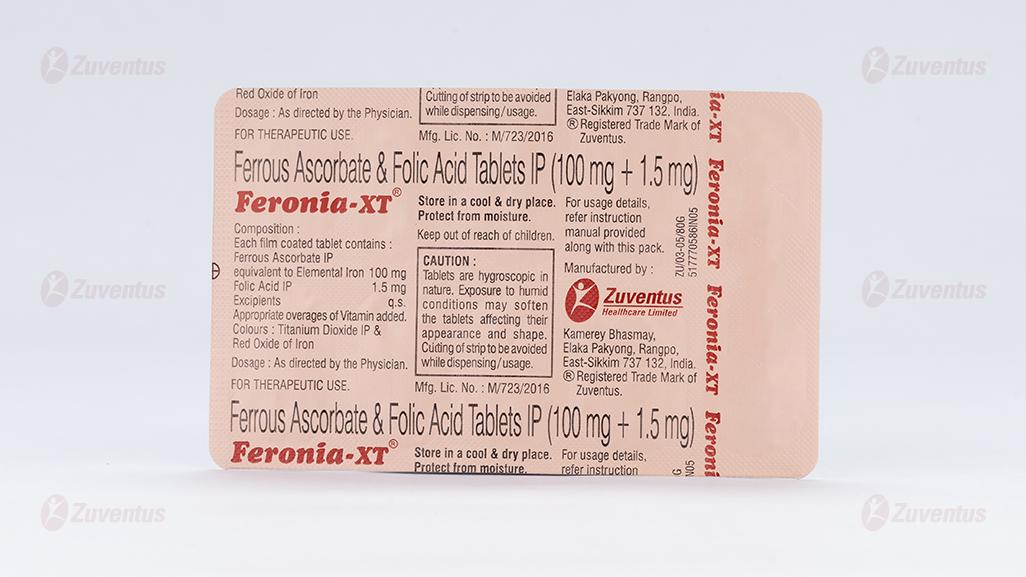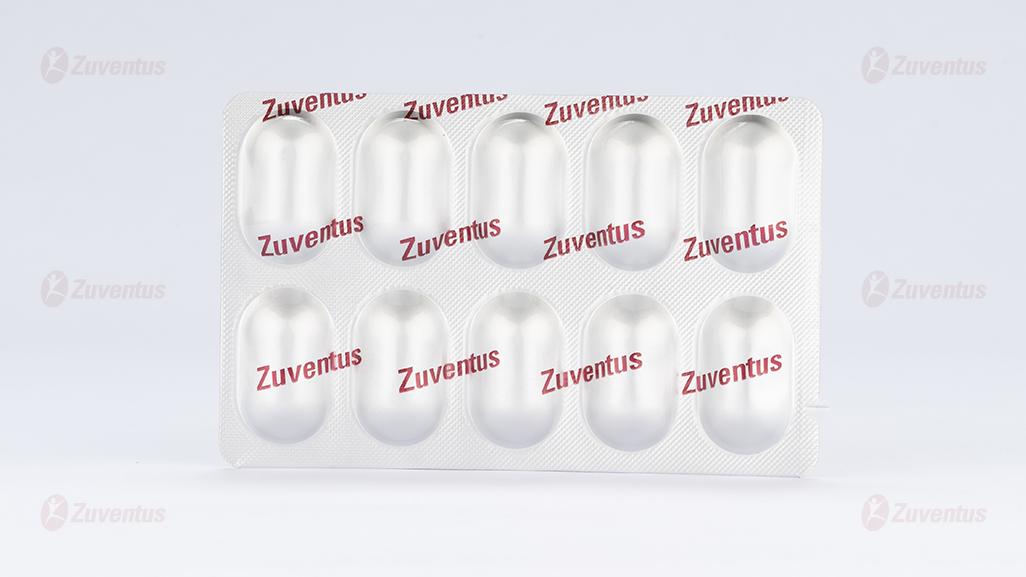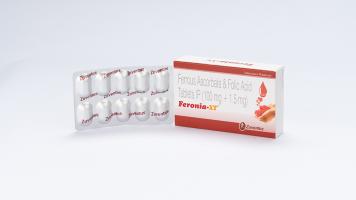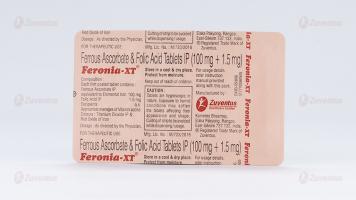Feronia XT Tablets
Therapy Area
Vitamins/Minerals Supplements
1.0 Generic Name
Ferrous ascorbate and Folic Acid tablets
2.0 Qualitative and Quantitative Composition
Each Film-coated tablet contains:
Ferrous ascorbate IP
equivalent to Elemental iron 100 mg
Folic Acid IP 1.5 mg
Appropriate overages of Vitamin added.
Excipients q.s.
Colour: Red Oxide of Iron and Titanium Dioxide IP
3.0 Dosage Form and Strength
Film coated tablet
Ferrous Ascorbate + Folic Acid [100 mg + 1.5 mg]
4.0 Clinical particulars
4.1 Therapeutic indications
For the treatment of iron deficiency anemia.
4.2 Posology and method of administration
Adults
One tablet once daily.
Method of administration
For oral administration. Pediatric population: Not applicable.
4.3 Contraindications
- Hypersensitivity to the active substances or any of the excipients.
- Known hypersensitivity to the product, Vitamin B12 deficiency, paroxysmal nocturnal hemoglobinuria, hemosiderosis, haemochromatosis, active peptic ulcer, repeated blood transfusion, regional enteritis and ulcerative colitis.
- Feronia XT Tablets must not be used in the treatment of anemias other than those due to iron deficiency.
4.4 Special warnings and precautions for use
- Feronia XT Tablets Contains Iron. Keep out of reach and sight of children, as overdose may be fatal.
- Some post-gastrectomy patients show poor absorption of iron. Care is needed when treating iron deficiency anemia in patients with treated or controlled peptic ulceration. Caution should be exercised when administering folic acid to patients who may have folate dependent tumors.
- Since anemia due to combined iron and vitamin B12 or folate deficiencies may be microcytic in type, patients with microcytic anemia resistant to therapy with iron alone should be screened for vitamin B12 or folate deficiency.
4.5 Interaction with other medicinal products and other forms of interaction
- Iron reduces the absorption of penicillamine. Iron compounds impair the bioavailability of fluoroquinolones, levodopa, carbidopa, thyroxine and bisphosphonates.
- Absorption of both iron and antibiotic may be reduced if Feronia XT is given with tetracycline.
- Absorption of both iron and zinc are reduced if taken concomitantly. Concurrent administration of antacids may reduce absorption of iron. Co- trimoxazole, chloramphenicol, sulphasalazine, aminopterin, methotrexate, pyrimethamine or sulphonamides may interfere with folate metabolism. Serum levels of anticonvulsant drugs may be reduced by administration of folate.
- Oral chloramphenicol delays plasma iron clearance, incorporation of iron into red blood cells and interferes with erythropoiesis.
- Some inhibition of iron absorption may occur if it is taken with cholestyramine, trientine, tea, eggs or milk.
- Administration of oral iron may increase blood pressure in patients receiving methyldopa.
- Coffee may be a factor in reducing iron bioavailability. Neomycin may alter the absorption of iron.
4.6 Fertility, pregnancy and lactation
Pregnancy and lactation:
Feronia-XT tablet is suitable for use during pregnancy and breastfeeding.
Fertility:
No fertility data is available
4.7 Effects on ability to drive and use machines
Feronia XT Tablets has no influence on the ability to drive and use machines.
4.8 Undesirable effects
Side effects may be minimised by taking the product with or after food or by starting with a small dose and increasing gradually. The incidences of undesirable effects are tabulated below. They are listed by system organ class and frequency defined as follows:
Very rare (<1/10,000)
Immune System Disorders: Rarely allergic reactions may occur.
Rare (≥1/10,000 to <1/1,000)
Gastro-intestinal disturbances (e.g. nausea, vomiting, constipation, diarrhoea)
Frequency Not known
- Renal and urinary disorders: darkening of the stools may occur.
- Metabolism and Nutrition Disorders: Haemosiderosis may occur as a result of excessive or mistaken therapy.
Reporting of suspected adverse reactions
Reporting suspected adverse reactions after authorization of the medicinal product is important. It allows continued monitoring of the benefit/risk balance of the medicinal product. Healthcare professionals are asked to report any suspected adverse reactions via email to: medico@zuventus.com
Website: http://www.zuventus.co.in/safety.aspx
4.9 Overdose
Symptoms:
Symptoms and signs of abdominal pain, vomiting and diarrhea appear within 60 minutes. Cardiovascular collapse with coma may follow. Some improvement may occur after this phase which, in some patients, is followed by recovery. In others, after about 16 hours, deterioration may occur involving diffuse vascular congestion, pulmonary edema, convulsions, anuria, hypothermia, severe shock, metabolic acidosis, coagulation abnormalities and hypoglycemia.
Management:
Vomiting should be induced immediately, followed as soon as possible by parenteral injection of desferrioxamine mesylate, and then gastric lavage. In the meantime, it is helpful to give milk and/or 5% sodium bicarbonate solution by mouth.
Dissolve 2g desferrioxamine mesylate in 2 to 3ml of water for injections and give intramuscularly. A solution of 5g desferrioxamine in 50 to 100ml of fluid may be left in the stomach. If desferrioxamine is not available, leave 300ml of 1 % to 5 % sodium bicarbonate in the stomach. Fluid replacement is essential.
Recovery may be complicated by long-term sequelae such as hepatic necrosis, pyloric stenosis or acute toxic encephalitis which may lead to CNS damage. Pediatric Population: Acute overdose of oral iron requires emergency treatment. In young children 200-250mg/kg Ferrous Ascorbate is considered to be extremely dangerous.
5.0 Pharmacological properties
5.1 Mechanism of Action
Ferrous Ascorbate is a synthetic molecule of ascorbic acid and iron and is used as a source of iron for iron deficiency anaemia. Ascorbate increases iron uptake in part by acting as weak chelator to help to solubilize the metal in the duodenum. Iron is readily transferred from these compounds into the mucosal lining cells. The absorbed iron is bound to transferrin and used for Hb synthesis in the bone marrow or stored, primarily in the liver, bound to ferritin.
Folic acid (folate) belongs to the group of B vitamins. It is a precursor to tetrahydrofolate, a coenzyme that is involved in various metabolic processes, including the biosynthesis of purines and thymidylates of nucleic acids. Folic acid is required for nucleoprotein synthesis and to maintain normal erythropoiesis.
Folic acid is the precursor of tetrahydrofolic acid which is active and acts as a co-factor for 1-carbon transfer reactions in the biosynthesis of purines and thymidylates of nucleic acids.
5.2 Pharmacodynamic properties
Pharmacotherapeutic group – Iron in combination with Folic Acid
ATC code – B03AD
There is evidence that a daily dose of 100mg of elemental iron in the ferrous form is adequate to prevent development of iron deficiency in expectant mothers. If a mild iron deficiency is present when Feronia-XT Tablets administration is started, this will be corrected by increased absorption of Iron. The daily folate requirement rises steeply during the final trimester of pregnancy, and evidence of maternal depletion may be found. The dose of folic acid required varies depending on the clinical condition. The most common therapeutic dose is in the range of 1-3 mg daily. To ensure normal tissue folate levels in the mother after delivery a daily supplement of about 1.5mg is required during the second and third trimester of pregnancy.
5.3 Pharmacokinetic properties
Absorption
Iron is absorbed chiefly in the duodenum and jejunum. Folic Acid is absorbed mainly from the proximal part of the small intestine.
Distribution
The amounts of Folic Acid absorbed from normal diets are rapidly distributed in body tissues.
Biotransformation
Absorption being aided by the acid secretion of the stomach and being more readily affected when the iron is in the ferrous state. Folic acid rapidly appears in the blood, where it is extensively bound to plasma proteins. When larger amounts are absorbed, a high proportion is metabolized in the liver to other active forms of folate and a proportion is stored as reduced and methylated folate.
Elimination Larger amounts of folate are rapidly excreted in the urine and about 4 to 5 micrograms is excreted in the urine daily.
Elimination
Larger amounts of folate are rapidly excreted in the urine and about 4 to 5 micrograms is excreted in the urine daily.
6.0 Description
This Feronia-XT tablet contains: Ferrous Ascorbate & Folic Acid as active ingredients, for the treatment of iron deficiency anemia.
Ferrous Ascorbate is an iron supplement used to treat or prevent low blood levels of iron (such as those caused by anemia or during pregnancy). Ascorbic acid (vitamin C) improves the absorption of iron from the stomach.
Molecular Formula- C12H14FeO12
Molecular Weight: 406.08g/mol
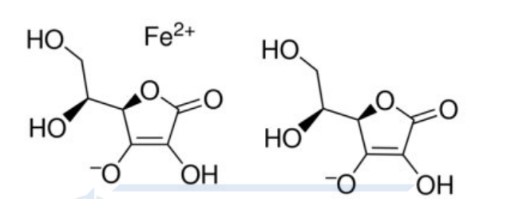
Chemical structure of ferrous ascorbate
Folic acid is used to treat anemia caused by folate deficiency. Folic acid is also used as a supplement by women during pregnancy to reduce the risk of neural tube defects (NTDs) in the baby.
Molecular Formula-C19H19N7O6
Molecular Weight- 441.4 g/mol
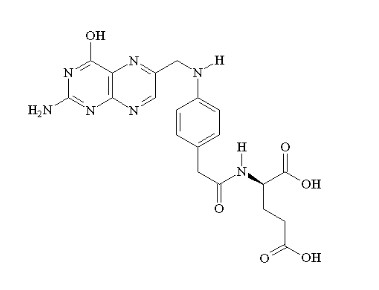
Chemical structure of Folic acid
7.0 Pharmaceutical particulars
7.1 Incompatibilities
Not applicable.
7.2 Shelf-life
Refer on pack
7.3 Packaging information
10 Blister strips of 15 tablets each
7.4 Storage and handing instructions
Store at a temperature not exceeding 25°C. Protect from light. Keep out of reach of children.
Instruction for Handling:
- Tablets are hygroscopic in nature. Exposure to humid conditions may soften the tablets affecting their appearance and shape. Cutting of strip to be avoided while dispensing / usage.
- User should have dry hands while removal of tablet.
- Tablet should not be kept in open pocket or in open condition after removal from strip.
8.0 Patient Counselling Information
Do not take Feronia XT tablets:
- if you are allergic to Ferrous Ascorbate and Folic Acid or any of the other ingredients of this medicine
- if you are breast-feeding or trying to become pregnant
- if you have been told you suffer from Vitamin B12 deficiency
- if you suffer from a blood disorder
- if you have had or are having repeated blood transfusions
- if you have a stomach ulcer or other digestive conditions such as regional enteritis or ulcerative colitis
- if you are suffering from anaemia that is not due to a lack of iron
Tell your doctor if you are taking any other medicines.
If you drink tea, coffee or milk or eat eggs at the same time as taking Feronia XT your body may absorb less of the iron supplement, which may reduce the effect of this medicine.
If you are pregnant or think you may be pregnant, ask your doctor for advice before taking this medicine.
Only use if you are more than 13 weeks pregnant. Do not use if you are breast-feeding or trying to become pregnant.
Always take Feronia XT Tablets exactly as your doctor has told you. You should check with your doctor or pharmacist if you are not sure.
Swallow the tablet whole with a glass of water.
About leaflet
Read all of this leaflet carefully before you start taking this medicine because it contains important information for you.
Always take this medicine exactly as described in this leaflet or as your doctor or pharmacist has told you.
- Keep this leaflet. You may need to read it again.
- Ask your pharmacist if you need more information or advice.
- If you get any side effects, talk to your doctor or pharmacist. This includes any possible side effects not listed in this leaflet.
- You must talk to a doctor if you do not feel better or if you feel worse.
What is in this leaflet
1. What Feronia XT is and what it is used for
2. What you need to know before you take Feronia XT
3. How to take Feronia XT
4. Possible side effects
5. How to store Feronia XT
6. Contents of the pack and other information
1. What Feronia XT is and what it is used for
Feronia XT film-coated Tablets (referred to as Feronia XT in this leaflet) contains two active substances Ferrous Ascorbate 100mg (an iron supplement) and Folic Acid 1.5mg (a vitamin supplement). These work together in the medicine.
Feronia XT belongs to a group of medicines called hematinic (Iron in combination with Folic Acid). Feronia XT works as a supplement. It provides the body with more iron and folic acid. These are important substances that your body needs to form red blood cells. If you do not have the right amount of these substances, it is possible that you may develop anaemia.
Feronia XT is used to prevent and treat low levels of iron and folic acid in the blood (such as those caused by anemia or during pregnancy). Ascorbic acid (vitamin C) improves the absorption of iron from the stomach.
Feronia XT Tablets is used to prevent and treat low levels of iron and folic acid in the blood during pregnancy after the first thirteen weeks. During pregnancy the body’s demands for iron and folic acid increase. Iron is important for the health of the mother and developing baby. Not enough iron may lead to anaemia in either the mother or baby. It is therefore important that the body gets enough iron for both the mother and the developing baby. Folic acid is very important for the development of a baby during pregnancy. It is therefore important that the body gets enough folic acid for both the mother and the developing baby.
You must talk to a doctor if you do not feel better or if you feel worse.
2. What you need to know before you take Feronia XT
Do not take Feronia XT:
- if you are allergic to Ferrous Ascorbate and Folic Acid or any of the other ingredients of this medicine
- if you are breast-feeding or trying to become pregnant
- if you have been told you suffer from Vitamin B12 deficiency
- if you suffer from a blood disorder
- if you have had or are having repeated blood transfusions
- if you have a stomach ulcer or other digestive conditions such as regional enteritis or ulcerative colitis
- if you are suffering from anaemia that is not due to a lack of iron If any of the above applies to you, talk to your doctor or pharmacist.
Warnings and precautions
Talk to your doctor before taking Feronia XT
- if you have been or you are being treated for a stomach ulcer
- if you have had or you have a folate dependent tumour
- if you have had all or part of your stomach removed
Feronia XT contains iron. Keep out of reach and sight of children, as overdose may be fatal.
Children
There is no relevant use of Feronia XT tablets in children.
Other medicines and Feronia XT
Tell your doctor if you are taking any other medicines.
- Antibiotics e.g. fluoroquinolones, cotrimoxazole, chloramphenicol, sulphonamides, tetracyclines, neomycin (used for infections)
- Anticonvulsant medicines (used for epilepsy)
- Antacids
- Penicillamine (used for rheumatoid arthritis)
- Sulfasalazine (used for rheumatoid arthritis and bowel disease, e.g. Crohn’s disease)
- Cholestyramine (used for reducing blood cholesterol or control diarrhea)
- Levodopa or Carbidopa (used for Parkinson’s disease)
- Thyroxine (used for thyroid disease)
- Bisphosphonates (used for bone disease)
- Aminopterin and Methotrexate (used for certain cancers)
- Pyrimethamine (used for malaria)
- Trientine (used for Wilson’s disease)
- Methyldopa (used for high blood pressure)
- Zinc
- Any other medicine, including medicines obtained without a prescription
Feronia XT with food and drink
If you drink tea, coffee or milk or eat eggs at the same time as taking Feronia XT your body may absorb less of the iron supplement, which may reduce the effect of this medicine.
Pregnancy and breast-feeding
If you are pregnant or think you may be pregnant, ask your doctor for advice before taking this medicine. Only use if you are more than 13 weeks pregnant. Do not use if you are breast-feeding or trying to become pregnant.
Driving and using machines.
There are no known effects on driving or using machines.
3. How to take Feronia XT
Always take this medicine exactly as described in this leaflet or as your doctor, or pharmacist has told you. Check with your doctor or pharmacist if you are not sure.
IMPORTANT: Your doctor or pharmacist will choose the dose that is right for you. Your dose will be shown clearly on the label that your pharmacist puts on your medicine.
If it does not, or you are not sure, ask your doctor or pharmacist.
DO NOT EXCEED THE STATED DOSE.
Too much iron can be harmful.
Swallow the tablet whole with a glass of water.
The recommended dose for adults
• The usual dose is one tablet to be taken each day by mouth.
If you take more Feronia XT than you should
If you accidentally take too much, contact the nearest hospital casualty department or your doctor immediately.
Symptoms of an overdose include stomach pain, diarrhea or being sick, within an hour of taking too much. Heart problems or collapse may follow.
If you forget to take Feronia XT
If you miss a tablet take one when you remember. Never take two tablets on the same day.
If you miss several tablets take a single tablet and talk to your doctor.
If you stop taking Feronia XT
Keep taking this medicine for as long as your doctor or pharmacist tells you to. Do not stop taking this medicine just because you feel better.
If you have any further questions on the use of this medicine, ask your doctor or pharmacist.
4. Possible side effects
Like all medicines, this medicine can cause side effects, although not everybody gets them.
Seek immediate medical help if you have an allergic reaction.
This includes any of the following symptoms:
- Difficulties in breathing
- Swelling of your eyelids, face or lips
- Rash or itching
Not known: frequency cannot be estimated from the available data
Upset stomach
Anorexia (e.g. loss of appetite)
Sickness
Constipation
• Diarrhea
• Darkening of stools
Reporting of side effects
If you get any side effects, talk to your doctor, pharmacist or nurse. This includes any possible side effects not listed in this leaflet. You can also report side effects directly: Website: www.zuventus.co.in and click the “Safety Reporting” located on the top of the home page.
By reporting side effects, you can help provide more information on the safety of this medicine. You can also report the side effect with the help of your treating physician.
5. How to store Feronia XT
- Keep this medicine out of the sight and reach of children. An overdose can be fatal.
- Do not use this medicine after the expiry date which is stated on the carton and blister after EXP. The expiry date refers to the last day of that month.
- Store below 25°C. Keep the blister in the outer carton in order to protect from light.
- Do not throw away any medicines via wastewater or household waste.
- Ask your pharmacist how to throw away medicines you no longer use. These measures will help protect the environment.
6. Contents of the pack and other information
What Feronia XT contains
- The active substances are Ferrous Ascorbate and Folic Acid.
- Each tablet contains 100 mg ferrous ascorbate and 1.5 mg folic acid.
What Feronia XT looks like and contents of the pack
10 Blister strips of 15 tablets each




